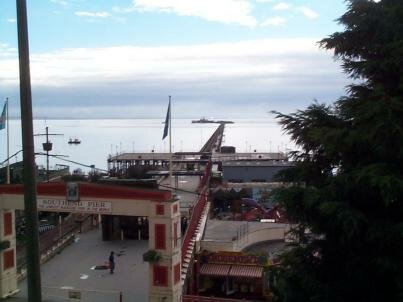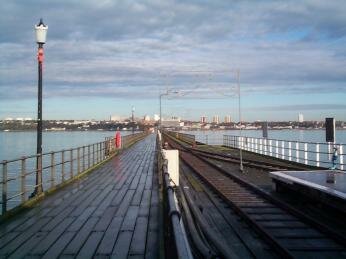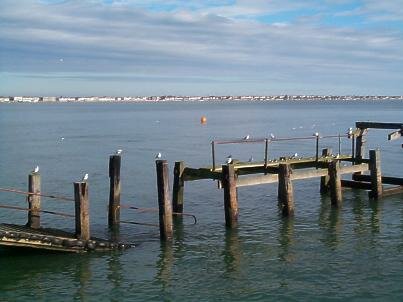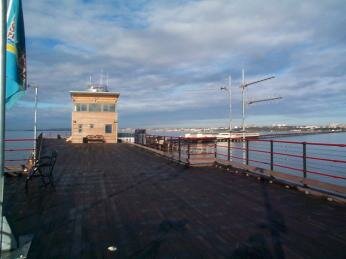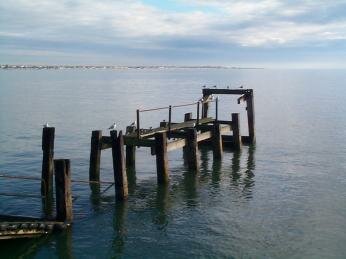BRIEF HISTORY Designed by James Brunlees, work on the new Southend Pier commenced in 1887 and was opened on 24th August 1890, complete with an electric railway. Various extensions and improvements over the next 30 years ensured that the Pier kept pace with visitor requirements. These included an extension to the pier head in 1897, increasing the pier's overall length to 7,080ft (2,145m) - a world record for a pier. An upper deck to the head was opened on 25th July 1908, and the eastern 'Prince George Steamer Extension' was added in 1929. In the mid 1970's as a result of rising costs, demolition was a possibility, the Council thankfully decided on a 15 year restoration plan, but these plans were put in jeopardy in July 1976 when the worst chapter in Southend Pier's long history unfolded. A serious fire completely gutted the extensive pier head. People stranded on the pier at the time were evacuated along the railway and by boat. Whilst firemen tackled the blaze from the structure, fire-fighting tugs tackled it from the sea, and a crop spraying light aircraft was used overhead. A year later the bowling alley at the shoreward end was badly damaged in a second fire, and 1978 saw the railway closed for safety reasons. Southend Piers fate was once again in the balance, but a local action group fought a stubborn campaign to secure its future. Rebuilding of the Pier began in November 1984, and a new Pier railway was opened by Princess Anne just two years later. Further problems were encountered in 1986 when a ship collided with the Pier, temporarily sectioning the structure near the head. A museum was constructed at the shoreward end, near the railway station, in 1989. Another fire on 7th June 1995 finally destroyed the shoreward end bowling alley, as well as causing considerable damage to the adjacent railway forcing it's closure for a period of time. Discussions still continue today to find a viable solution that will provide a sound future for the worlds longest Pier. WHY VISIT THE PIER? The Pier has several advantages over nearby Canvey Island, chiefly its position. Protruding out into the Thames estuary for well over a mile can result in close views of the birds as you can feel that you are actually out there with them. Generally though, most birds will be no further away than those viewed from Canvey and can be viewed as close as it is possible without getting on a boat. There is always the possibility of getting an excellent view of Divers, Grebes and Skuas which is always more satisfying than a distant fly by. Just a few of the highlights over the years include the Great Northern Divers in 1997 that spent the winter dismantling crabs right under the board walk, the Pomarine Skuas that were seen chasing Kittiwakes around the Pier head, the ten Long-tailed Skuas in September 1991 and the Leachs Petrels in 1989. The Pier head has a Pub, just in case you fancy celebrating that Soft Plumaged Petrel you just saw go past, a caf, a burger bar, souvenir shop, arcades, toilets and a telephone box
THE BIRDS OF THE PIER Over the years, visitors have asked why there should be seabirds in the estuary and on such a regular basis. The answer may actually be a simple one. During the autumn seabirds such as Skuas and Shearwaters move south through the North Sea tracking the east coast as they go. When they reach Essex, they continue to track the coastline which gets progressively further west until it reaches the Thames Estuary. The north Kent coast then acts as an immediate barrier to these birds which then subsequently continue to follow their westerly movements up the estuary passing the Pier and Canvey as they go. Eventually they reach the Thames Barrier and realise they cant go any further and turn around and head back out of the estuary. This has been confirmed by observations of birds flying up the river and an hour or so later the same birds are then seen flying back the other way, generally a lot closer than when they went up river. It is not only seabirds that get seen from the Pier, birds of prey and other passage migrants have also been noted crossing the river here, a feature also shared by Canvey but, due to that location's shorter crossing distance, Canvey tends to get more raptors, 2000 was an outstanding year for raptor passage. The bird of the Pier, however, goes to the Mediterranean Gull which can be seen virtually daily with numbers peaking in winter in the double figures. The birds tend to roost on the old slipway posts and readily come to offered bread. The Pier is generally regarded as the best place to see this species in Essex and one of the best in East Anglia. During recent years we have seen numbers of ringed Mediterranean Gulls and, through tracking the rings, we have found that the birds originate from France and as far away as the Czech Republic.
It is evident that birders have somewhat neglected the Pier in recent years in favour of Canvey. This is reflected in the diminishing numbers of seabirds being recorded from the Pier and the increasing numbers being seen from Canvey. Increased observer presence would surely redress the balance and the Pier would again become a focal point for Essex Seawatchers. WHERE TO VIEW FROM In past years the best vantage points have been along the front, underneath the upper deck, looking out across the river and also from the very end looking out towards the outer estuary, the second option has generally been preferred by local birders as you can watch the birds moving up the estuary rather than when they just go past. The only problem with standing here is that during a strong north easterly wind you get it straight in the face whereas the front is far more sheltered. Both, however, give you the opportunity to keep an eye on the lifeboat bay which can attract numerous birds seeking the more sheltered conditions. It is worth remembering that if you can get here early then you stand a better chance of getting a good spot as fishermen are generally at the railings, especially at weekends. WHEN TO VISIT Autumn: From mid to late August Skuas will start to appear with numbers increasing through September and October then tailing off in November and early December. During the autumn period birds appear on a regular basis with Arctic, Pomarine and Great Skuas being seen with a chance of Long-tailed Skua, which is almost an annual occurrence off nearby Canvey. Black Terns, Gannets, Fulmars, Little Gulls, Kittiwakes and various other species can be seen almost daily in the right conditions while Sabines Gull, Sooty and Manx Shearwaters are all possible. Later in the season Little Auks and Leachs Petrels are strong possibilities, if the right conditions prevail. The best conditions during autumn will be a strong easterly wind with the best being in a north easterly direction when many seabirds will get blown straight into the estuary and past the Pier. In the past few years the chances of seeing both Common Seals and even Porpoises has increased. Sightings in 2000 include Bottlenose Dolphin on the 29th of July approximately 800 metres southwest of the Pier, 3 Common Dolphin on the 4th of July and 3 Harbour Porpoise on the 10th of September. Winter: Winter can be very rewarding from mid November through to early April resulting in 3 species of Diver, Red-necked and Slavonian Grebes, Purple Sandpiper, Auks, Seaducks and even a few Skuas can linger. The best weather conditions to visit in winter would be during cold a north easterly wind especially if coinciding with a severe cold snap. This could result in the reservoirs freezing over, forcing wildfowl into the river. Divers, especially Great Northern, have been seen right under the boardwalk and can be watched from just a few feet away. The lifeboat bay can often hold Divers and the scarcer Grebes. Red-necked and Slavonian Grebes have all been regular winter visitors but due to recent mild winters they have become a lot harder to come by, however, they can still be found on some visits. Summer: Summer is certainly not the best time to visit the Pier in the hope of seeing seabirds as most would be back on their breeding grounds and the estuary would generally only have a few Terns in residence. This, coupled with the fact that you may need to fight your way past the hundreds of tourists that visit in summer, would result in a difficult day's birding. Late July and early August though would generally have a few Black Terns and the odd early Skua moving through. Other Factors: When visiting the Pier it is best to consult, if possible, the local tide table. The rising tide from 2 - 3 hours prior to, and including high water, are by far the best and, to a lesser extent, the falling tide. If this should coincide with an easterly gale, and is early in the morning, then the chance of some good birds is high. This said, good birds can nearly always be seen on a rising tide no matter what time of day. A visit when the tide is out will be harder than on a rising tide although some birds, of course, will be seen as there is always permanent deep water around and beyond the end of the Pier. Generally though a low tide will mean fewer birds. The worst times to visit the Pier for a birder can be on bright sunny days when glare will more or less cover the entire surface of the water restricting where you can look without getting blinded, another difficulty would be foggy days and during strong westerly winds. If the day is sunny with a westerly wind then you will be hard pressed to find anything at all. However, there are exceptions to the rule such as the near hurricane force westerly winds in 2000 which brought both Leachs Petrel and an unprecedented number of Storm Petrels to the estuary. These birds were seen from Canvey Island and, as this event was during mid week, no one was present at the Pier so birds were almost certainly missed here. Other events can cause many birds to enter the river in even the most unlikely of weather conditions, one of these being the sprat shoals. Tens of thousands of gulls will follow these into the river with the obligatory Skuas in pursuit. Divers, Grebes, auks and other diving birds also follow and can result in an excellent days birding. Such events occurred in the winter of 1986 for example when, amongst others, hundreds of Guillemots could be seen almost daily. To get the best out of the Pier a few hours should be spent watching rather than just a flying visit as birds have a tendency to appear at random. Again though, there is always the exception to defy the rule. In December 2000 a local birder made a flying late afternoon visit and found an adult Franklin's Gull flying past behind a fishing boat so it just goes to show anything is possible. Occasionally the Pier can be shut when extreme severe weather moves in, these can be Hurricane force winds or a foot of snow on the boardwalk but Pier closures are uncommon. If this does occur places such as Canvey Seafront and Shoeburyness are the nearest seawatching points.
FUTURE DEVELOPMENT Currently there is a new upper deck which is ideal for birdwatchers, the work being completed in autumn 2001. However, there have been more worrying development plans for the Pier that have been suggested over the years. These have ranged from a 2000 berth mooring Marina that would have covered most, if not all, of the mud flats directly south of the coastline. More recently was the plan to build the Swine rollercoaster at the very end of the Pier. This would have been the largest rollercoaster in Europe but these plans, thankfully, appear to have been dropped LOCATION Southend Pier is located along the sea front just below the Palace Hotel and by the Adventure Island Theme Park and extends 1 and a third miles out into the Thames Estuary. This allows the opportunity to watch seabirds that are otherwise difficult to see in Essex. ACCESS There is plenty of parking along the adjacent seafront with meters that operate daily. There are a few places nearby where parking is free but a walk may be involved to reach the Pier itself. There is free Sunday parking along the meters at the top of Pier hill but these can soon fill up with Sunday shoppers after 10am. Opening times can be a little late for the most enthusiastic seawatcher with the walkway open at 8am and the first train in winter not until 9am. Walking: Access to the walk way is via the top deck and can be quite bracing if there is cold wind blasting its way down the estuary. During the winter months it is free to walk in both directions but there is a charge of 2 during the summer period which, unfortunately, includes the best autumn seawatching months. This charge may be the reason for the diminishing bird sightings over the years from August through to November. Along the boardwalk there are numerous benches to stop at and three covered shelters which are more or less taken over in winter by fishermen. Train: The alternative to walking is the train. This is a short 10 minute ride from the lower deck and departs on the hour and half hour and costs 2.50 to ride in both directions. The problem with the train is if that you happen to see something on the journey up you cant stop to have a look.
For more details of the Gulls of Southend see our page Gulls in Southend Article by Steve Arlow, Southend Ornithological Group. |
Page last updated:
Web Design Graham Mee. © Copyright of all pages South East Essex RSPB Local Group. All images copyright of owners
The Royal Society for the Protection of Birds. Registered charity no 207076


